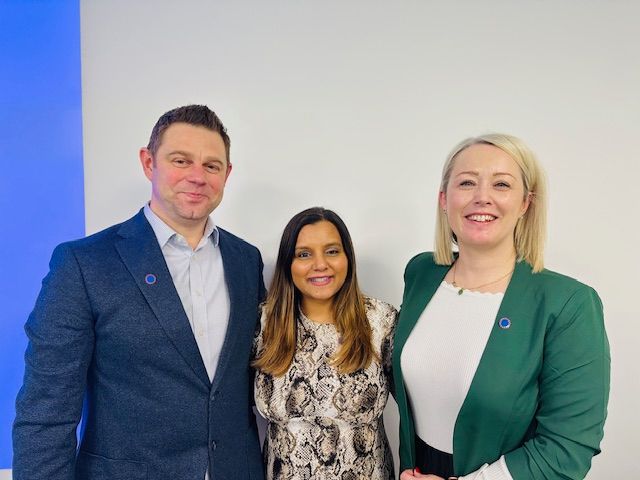From leadership to collaboration: why the AHP Quality and Safety Senior Leadership Programme is essential for radiographers
Synergy speaks to Malany Kalicharan, Benjamin Roe and Dr Janice St. John-Matthews about how the programme can support senior AHP leaders

The AHP Quality and Safety Senior Leadership Programme was co-produced by the National Chief Allied Health Professions Officers team in England and NHS Confederation to help allied health professionals (AHPs) senior leaders navigate issues that might arise within quality and safety governance.
Benjamin Roe, clinical quality and improvement director at NHS England South West, Dr Janice St. John-Matthews, senior AHP adviser in the Office of the Chief AHP Officer at NHS England, and Malany Kalicharan, work and health integration programme manager and deputy chair of the Chief AHP Officer BAME Statutory Advisory Group, took part in the programme.
Synergy speaks to Benjamin and Malany about the programme and why radiographers should want to get involved.
Benjamin Roe, Malany Kalicharan and Dr Janice St. John-Matthews
Benjamin Roe, Malany Kalicharan and Dr Janice St. John-Matthews
The AHP Quality and Safety Senior Leadership Programme was co-produced by the National Chief Allied Health Professions Officers team in England and NHS Confederation to help allied health professionals (AHPs) senior leaders navigate issues that might arise within quality and safety governance.
Benjamin Roe, clinical quality and improvement director at NHS England South West, Dr Janice St. John-Matthews, senior AHP adviser in the Office of the Chief AHP Officer at NHS England, and Malany Kalicharan, work and health integration programme manager and deputy chair of the Chief AHP Officer BAME Statutory Advisory Group, took part in the programme.
Synergy speaks to Benjamin and Malany about the programme and why radiographers should want to get involved.
Benjamin Roe, Malany Kalicharan and Dr Janice St. John-Matthews
Benjamin Roe, Malany Kalicharan and Dr Janice St. John-Matthews
Can you tell us about the AHP Quality and Safety Senior Leadership Programme?

Benjamin Roe: I have been involved in developing the AHP Safety and Quality and Safety Senior Leadership Programme because of my role as a regional clinical quality and improvement director at NHS England and as an AHP (Therapeutic Radiographer) myself. Throughout my career, I have been involved in clinical quality and safety both through the profession-specific lens and more recently in a regional role, which spans responsibility across all clinical services.
Over the years, I have seen first hand how AHPs often feel underrepresented in safety and quality leadership. Research has shown that AHPs more broadly are significantly underrepresented in NHS trust board discussions and national quality reports, potentially limiting their influence on patient safety and quality improvement efforts.
Following a ‘Spotlight: In conversation’ webcast with Suzanne Rastrick, chief AHP officer, where I reflected on the role of senior AHPs working in quality and safety and offered clinical safety insights into the part AHPs can play in delivering high-quality services, I was asked by the national Office of the Chief Allied Health Professions Officer to support a priority piece of work. This work aimed to support the skills development and confidence of the integrated care board chief AHPs across England, with the goal of broadening the influence of AHPs in the quality and safety agendas.
The aim of the programme is to empower and build the confidence of senior AHP leaders around quality and safety and to develop a network of leaders to influence the quality and safety agenda at national, regional and system levels.
I wanted to ensure that AHPs not only understood quality frameworks but also felt confident in leading and embedding them within their organisations. The programme focuses on leadership development, multidisciplinary collaboration and practical applications of safety and quality governance so that AHPs can drive meaningful change in their workplaces.
The aim of the programme is to strengthen the leadership capability of AHPs in safety and quality governance. Historically, AHPs have played a crucial role in healthcare delivery but have not been as visible in governance and strategic decision making. This programme seeks to change that by equipping senior AHP leaders with the skills, knowledge and confidence to contribute to and influence patient safety, quality improvement and clinical governance at all levels .
Through a structured six-month leadership programme, participants will gain insights into strategic leadership, cultural change, mentorship, risk management and technical safety knowledge. The goal is to ensure that AHPs have a strong voice in shaping NHS safety and quality frameworks, ultimately improving patient care and system-wide collaboration.
Why is the programme important for radiographers?

BR: Several key elements of the programme are particularly relevant to radiographers and build on their strong skillset:
- Strategic leadership – developing leadership skills ensures they can influence system-wide quality and safety decisions, which impact on radiographic services.
- Patient safety and quality governance – understanding safety systems, risk assessment and reporting mechanisms empowers radiographers to lead on quality improvement initiatives beyond their own professional setting.
- Just culture and psychological safety – radiographers need to feel safe to report concerns and participate in governance without fear of blame. The programme emphasises fostering a culture where learning and accountability go hand in hand.
- Multidisciplinary collaboration – AHPs work alongside doctors, nurses and other professionals. Developing strong collaboration skills helps ensure that patient care is coordinated and effective across care pathways.
These elements are crucial because radiographers play an essential role in patient safety and have key skills built into training and practice that are transferable to other service settings. However, their contributions have often been overlooked in governance structures. This programme ensures they are equipped to take on senior leadership roles and advocate for their professions effectively.
How can radiographers apply what they learn from the programme to their professional lives?

BR: Radiographers can apply their learning in several ways:
- Leading quality improvement initiatives – participants will be equipped with the skills to identify safety concerns, implement quality improvement projects and advocate for changes that enhance patient care.
- Embedding a just culture – AHPs can foster open, fair environments within their teams, encouraging transparent safety reporting and shared learning.
- Engaging in governance and decision making – the programme prepares AHPs to take on leadership roles in clinical governance, ensuring that AHP perspectives are represented at trust boards and policy discussions.
- Mentoring and coaching – participants will develop the skills to support frontline AHPs, helping to build a wider network of safety-conscious and quality-driven professionals.
By applying these skills, AHPs can drive lasting improvements in patient care and system-wide safety cultures.
Why should radiographers want to take part in leadership programmes like these?

BR: Programmes like this provide them with the tools, confidence and leadership skills necessary to make a meaningful impact on patient safety and quality governance. Participants will gain:
- Recognition and representation – the programme helps AHPs secure a stronger voice in decision making at trust and system levels.
- Enhanced leadership skills – it builds their ability to influence change, manage teams and drive safety and quality initiatives.
- Practical knowledge and tools – they will learn how to implement the NHS patient safety strategy, use quality improvement frameworks and apply just culture principles in practice.
- A professional network – the programme brings together senior AHP leaders from across the NHS, fostering collaboration and support and a peer network of AHPs who share a vision for quality, safety and equitable healthcare.
Ultimately, AHPs who take part in this programme will be better positioned to influence healthcare policy, improve safety outcomes and advocate for their professions in a meaningful way.
Malany Kalicharan: as deputy chair of the BAME Statutory Advisory Group and a radiographer, my inclusion in the Quality and Safety Senior Leadership Programme has served several key purposes:
- Embedding equity in leadership – ensuring that diverse perspectives, particularly those representing minority communities, are integrated into senior leadership discussions on quality and safety.
- Influencing policy and decision making – providing insights and lived experiences that can help shape more inclusive policies, addressing disparities in safety and quality outcomes.
- Strengthening representation – enhancing the visibility and influence of radiographers and minority leadership within senior decision-making forums, fostering a more inclusive leadership culture across AHPs.
- Driving systemic change – contributing to the development of strategies that improve equity in healthcare or other institutional settings by ensuring safety and quality initiatives consider diverse needs.
- Collaboration and knowledge sharing – building networks with senior leaders to share best practices, challenges and solutions for creating safer and more equitable environments.
Why is it important to represent AHPs in governance and key reports?

BR: AHPs are the third largest professional group in the NHS, but historically there is a perception that their skills and expertise may have been underrepresented in quality training, governance, reporting and key investigations. There is a sense that the viewpoints, patient perspectives and impacts across care pathways that AHPs often bring may be a critical element in the shift to systems thinking in patient safety. Improving the engagement and representation of AHPs will lead to their perspectives being incorporated and engaged in quality and safety strategies alongside multiprofessional clinical partners.
The programme aims to ensure that this changes by:
- Developing AHP leadership at strategic levels – training AHPs to take on roles in safety and quality governance and equipping them with the skills to contribute to policy discussions.
- Advocating for AHP inclusion in governance structures – encouraging trusts and NHS bodies to appoint AHPs to board-level roles and involve them in decision-making processes.
- Building a network of safety and quality leaders – connecting AHPs across regions to collaborate, share insights and collectively influence NHS governance.
- Promoting the use of AHP data in quality reporting – highlighting the need for improved data collection and reporting on AHP contributions to patient safety and quality improvement.
By increasing radiographer and wider AHP visibility in these areas, the programme helps ensure that their expertise and leadership play a central role in shaping the future of NHS safety and quality governance.
MK: It was a privilege to be part of this programme as:
- Radiographers play a critical role in patient pathways, yet they are often underrepresented in strategic decision-making and governance.
- Having diverse voices in leadership is essential to shaping policies that truly reflect the workforce and patient population.
My participation bridged the gap between advisory work and executive-level strategy, ensuring that diversity, equality and inclusion remain central to leadership discussions on quality and safety.
More about
The SoR has a number of resources for members who wish to step into leadership roles. This includes the Leadership Mentoring Scheme, a programme that allows mentees to receive one-to-one mentoring with senior leaders within radiography.
For the 2025-26 edition of the scheme, successful applicants must be available on 21 October, 4 November and 13 November for training and launch events. The application deadline is 5pm on 30 June. To find out more information about the scheme, click here.
The SoR also publicises three popular NHS leadership programmes: the Edward Jenner leadership programme, the Mary Seacole programme and the Stepping Up programme. For more information about these, click here.
The Society of Radiographers also hosts the Strategic Senior Leadership Specialist Interest Group (SSL-SIG) The purpose of the SSL-SIG Network for AHP Leads and Directors in Radiography is to provide a supportive forum for AHP leaders who work in strategic roles and are qualified, HCPC-registered radiography professionals. The group is inclusive of the four nations: England, Northern Ireland, Scotland and Wales. The group is chaired by Dr Gareth Hill and Dr Janice St. John-Matthews.
Image credit: Getty Images




